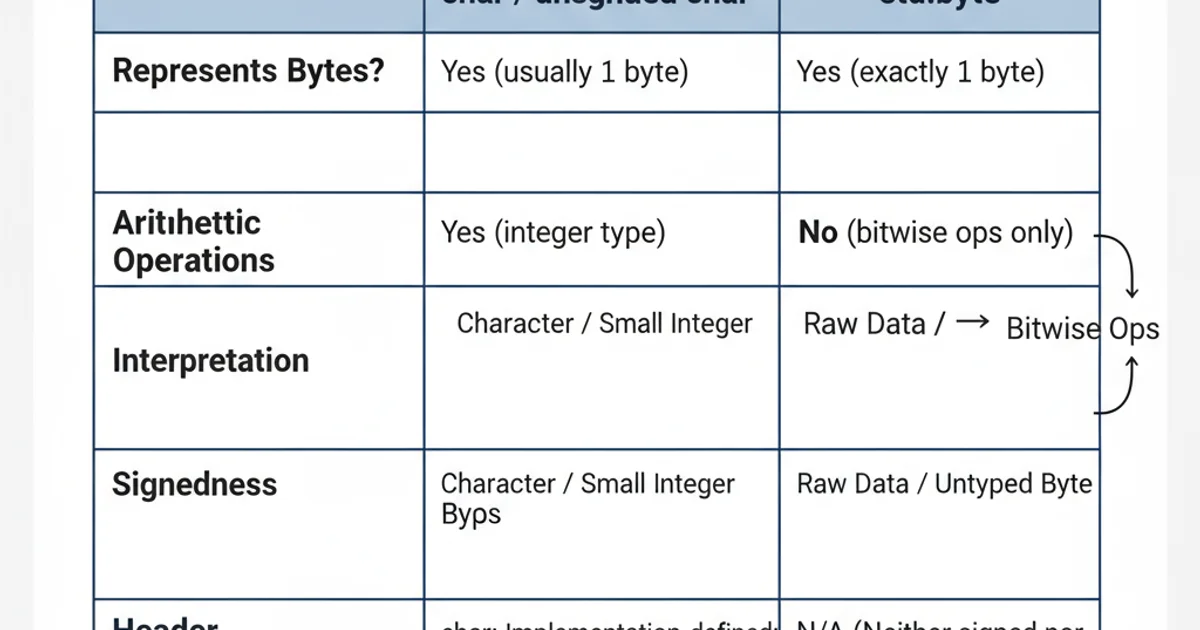Is there 'byte' data type in C++?
Categories:
Understanding 'byte' in C++: From char to std::byte

Explore the evolution of byte representation in C++, from its historical use of char to the modern, type-safe std::byte introduced in C++17, and learn how to use it effectively.
In C++, the concept of a 'byte' has evolved significantly over the years. Historically, the char type was often used to represent a byte, leading to potential ambiguities due to its character-related semantics. With the advent of C++17, a dedicated type, std::byte, was introduced to provide a clear, type-safe way to work with raw memory bytes. This article delves into the nuances of byte representation in C++, explaining the rationale behind std::byte and demonstrating its practical application.
The Historical Use of char for Bytes
Before C++17, there was no distinct type specifically for raw bytes. Programmers commonly resorted to using char, unsigned char, or signed char to represent a byte of data. While unsigned char was often preferred because it guaranteed a range from 0 to 255 (assuming an 8-bit byte, which is almost universally true today), its primary purpose was still character representation. This dual nature could lead to confusion and unintended implicit conversions, especially when dealing with arithmetic operations or I/O streams that might interpret the data as characters rather than raw binary values.
#include <iostream>
#include <vector>
void print_bytes_char(const std::vector<unsigned char>& data) {
for (unsigned char b : data) {
std::cout << static_cast<int>(b) << " "; // Cast to int to print numeric value
}
std::cout << std::endl;
}
int main() {
std::vector<unsigned char> buffer = {0x1A, 0xFF, 0x00, 0x7B};
std::cout << "Bytes using unsigned char: ";
print_bytes_char(buffer);
return 0;
}
Example of using unsigned char to represent and print bytes.
unsigned char is often used for byte manipulation, be cautious of implicit conversions to int during arithmetic operations or when passing to functions expecting character types, which can lead to unexpected behavior if not handled carefully.Introducing std::byte in C++17
C++17 introduced std::byte (defined in the <cstddef> header) as a distinct type to represent raw bytes. The key characteristic of std::byte is that it is an enumeration type (enum class) that is not a character type and not an arithmetic type. This design choice prevents accidental arithmetic operations or implicit conversions to other types, thereby enhancing type safety and making the intent of the code clearer. std::byte is specifically designed for byte-level memory access and manipulation, such as reading from or writing to memory buffers, network packets, or file I/O.
flowchart TD
A[Raw Data] --> B{Memory Buffer}
B --> C{Read/Write Operation}
C --> D["std::byte (C++17)"]
D --> E["Type-Safe Byte Manipulation"]
C --> F["char/unsigned char (Pre-C++17)"]
F --> G["Potential Type Ambiguity"]
style D fill:#bbf,stroke:#333,stroke-width:2px
style E fill:#ccf,stroke:#333,stroke-width:2px
style G fill:#fbb,stroke:#333,stroke-width:2pxEvolution of byte representation in C++: from ambiguous char to type-safe std::byte.
Working with std::byte
std::byte supports bitwise operations (AND, OR, XOR, NOT, shift) but does not allow direct arithmetic operations (addition, subtraction, multiplication, division). To perform arithmetic, you must explicitly cast std::byte to an integer type (e.g., int or unsigned char). Similarly, to convert an integer type back to std::byte, you use static_cast<std::byte>(). This explicit casting requirement reinforces its role as a raw byte container, preventing common pitfalls associated with char.
#include <iostream>
#include <vector>
#include <cstddef> // For std::byte
// Helper function to print std::byte values
void print_bytes_std_byte(const std::vector<std::byte>& data) {
for (std::byte b : data) {
// Cast to unsigned int to print numeric value
std::cout << static_cast<unsigned int>(b) << " ";
}
std::cout << std::endl;
}
int main() {
// Creating a vector of std::byte
std::vector<std::byte> buffer = {std::byte{0x1A}, std::byte{0xFF}, std::byte{0x00}, std::byte{0x7B}};
std::cout << "Bytes using std::byte: ";
print_bytes_std_byte(buffer);
// Bitwise operations
std::byte b1 = std::byte{0b10101010};
std::byte b2 = std::byte{0b00001111};
std::byte b_and = b1 & b2;
std::byte b_or = b1 | b2;
std::byte b_xor = b1 ^ b2;
std::byte b_not = ~b1;
std::byte b_shift_left = b1 << 2;
std::byte b_shift_right = b1 >> 4;
std::cout << "\nBitwise operations with std::byte:\n";
std::cout << "b1: " << static_cast<unsigned int>(b1) << " (0x" << std::hex << static_cast<unsigned int>(b1) << ")\n";
std::cout << "b2: " << static_cast<unsigned int>(b2) << " (0x" << std::hex << static_cast<unsigned int>(b2) << ")\n";
std::cout << "b1 & b2: " << static_cast<unsigned int>(b_and) << " (0x" << std::hex << static_cast<unsigned int>(b_and) << ")\n";
std::cout << "b1 | b2: " << static_cast<unsigned int>(b_or) << " (0x" << std::hex << static_cast<unsigned int>(b_or) << ")\n";
std::cout << "b1 ^ b2: " << static_cast<unsigned int>(b_xor) << " (0x" << std::hex << static_cast<unsigned int>(b_xor) << ")\n";
std::cout << "~b1: " << static_cast<unsigned int>(b_not) << " (0x" << std::hex << static_cast<unsigned int>(b_not) << ")\n";
std::cout << "b1 << 2: " << static_cast<unsigned int>(b_shift_left) << " (0x" << std::hex << static_cast<unsigned int>(b_shift_left) << ")\n";
std::cout << "b1 >> 4: " << static_cast<unsigned int>(b_shift_right) << " (0x" << std::hex << static_cast<unsigned int>(b_shift_right) << ")\n";
// Converting from int to std::byte
int value = 200;
std::byte converted_byte = static_cast<std::byte>(value);
std::cout << "\nConverted int 200 to std::byte: " << static_cast<unsigned int>(converted_byte) << std::endl;
return 0;
}
Demonstrating std::byte initialization, bitwise operations, and casting.
char* or void* for raw memory, you can safely cast std::byte* to void* or char* (and vice-versa) to maintain compatibility while still using std::byte internally for type safety.Why std::byte is Important
The introduction of std::byte addresses a long-standing need in C++ for a type that clearly signifies its purpose: representing a raw unit of data. It improves code clarity, prevents common programming errors related to implicit type conversions, and makes code more robust. By explicitly disallowing arithmetic operations, it forces developers to consider the byte's value as a bit pattern rather than a numerical quantity, which is crucial for low-level memory and data manipulation tasks. This makes std::byte the preferred choice for scenarios like serialization, deserialization, network communication, and cryptographic operations where precise byte-level control is essential.

Feature comparison: char vs. unsigned char vs. std::byte